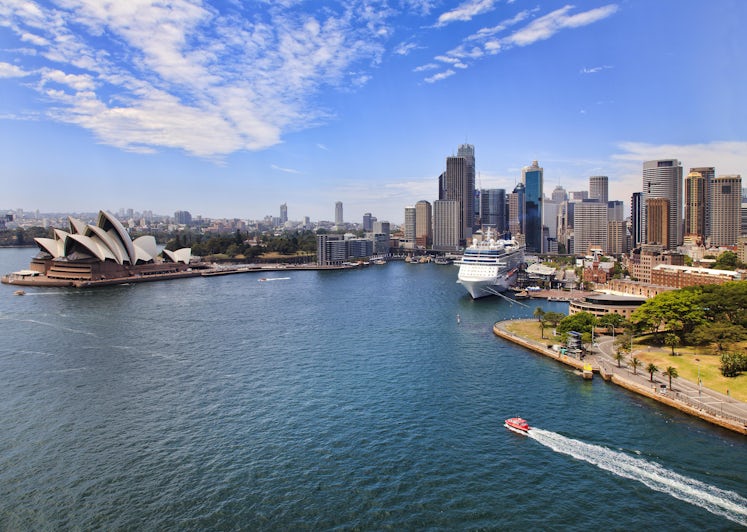
Cruise Supplies: The Longest Shopping List in Australia


A cruise shopping list is very long and unpredictable. Just ask Jeremy Goodman, P&O Cruises' Director of Supply Chain, who oversees the supplies for local P&O, Carnival Cruise Line, Princess Cruises, Holland America Line, Cunard and Seabourn ships. From working on product development to ensuring there is always enough toilet paper onboard, there is no task too big or too small for Goodman and his hard-working team. We asked him what it’s like managing one of the world’s longest shopping lists.
**1. Do you work on the ship, on land or a little of both? **Mostly on land and in the air. Unfortunately, we don't get as much time at sea as people might think as we're either in the office working on projects or out meeting with vendors or meeting ships at port as they're loading. We have a large geographical scope that reaches into the Pacific Islands and South East Asia, as well as strong ties in the US so we're fairly regular travellers.
2. What kind of numbers are you dealing with when it comes to stocking up on food and drinks? This year, P&O Cruises Australia will purchase more than 500 tonnes of beef, 600 tonnes of chicken and 200 tonnes of bacon. Then there is 20 tonnes of espresso coffee, which might not seem like much at first glance but it's a lot when you consider just 10 grams of coffee goes into a shot of espresso. On any given day, the P&O Cruises' fleet goes through about 1400kg of beef, 1700kg of pork, 2000kg of chicken, 2500 tonne of fruit and vegetables and 4000 bottles of water.
3. How much of the fresh produce is Australian? All food and beverage is sourced from Australian suppliers. As Australia's 'home-grown cruise line', supporting Australian suppliers and the local economy is a big part of our mantra. The majority of our fruit, vegetables, beef, pork, poultry and lamb is Australian. Additionally, all of Carnival Corporation's 105 ships use Australian lamb, which we source as one group.
**4. How long can a P&O ship go without restocking? **A ship can typically go for about two weeks. However, we tend to work around when the ship is due back at its home port. It's rare that a ship does a voyage that is longer than two weeks.
**5. How do you ensure the ship doesn't run out of items during a cruise? **It's all in the planning. We've got very experienced teams onboard who are experts in knowing how to plan the ship's requirements. With their huge experience, it's very rare for the team to get things wrong, but we're always ready to 'expect the unexpected' and we have a good network of vendors in most of the ports where we call.
6. What is the one item that you can never predict its demand? Breakfast cereal! It's amazing how the demographics on a cruise change consumption of what we may consider to be 'everyday' products. Fortunately, we have enough of a variety of dining options onboard that we rarely run into issues
7. Do you ever buy different things for different cruises or at different times of the year? We bring on specialty products at Christmastime, however, so much product is made from scratch onboard that it's rare that we don't already stock a product that we need. We might just need to change the volumes to address demand.
8. What are the most challenging items to purchase? Seasonal items can be challenging. Generally speaking 'fruit and veg' isn't a big issue, however we do see challenges with seafood at certain periods. On top of that we have the everyday challenges of Mother Nature keeping our lives interesting with drought, cyclones, floods, heat, cold and other variables.
9. What hard-to-get items have you been asked to track down? The hardest item I've ever needed to source was in April of this year when a Seabourn ship was in Bali. It was the Jewish festival of Passover and Seabourn wanted to offer its Jewish guests the traditional Passover food of matzah [unleavened flatbread] – certainly not the easiest thing to find in Indonesia. But one thing led to another and, to cut a long story short, the ship got its matzah!
10. It's a long way to the nearest shop when you're in the middle of the ocean. What is your worst nightmare? My nightmare as a supply chain director is running out of toilet paper. Fortunately, that particular bad dream hasn't eventuated because we've always had the right toilet paper on the right ship in the right volumes at the right time. It's all in the planning.
11. What do you enjoy most about your job? The people aspect, and that comes on many levels. We're constantly asking ourselves what impact our decisions will have on the guest experience. We always want to over-deliver to our guests and we're mindful that another 'day in the office' to us may have significant impact on someone's once-in-a-lifetime dream holiday. Then there is the crew onboard and how a late arrival, last-minute change, or supplier shortage may impact their ability to do their jobs.
Last, but certainly not least, there is the social impact we have based on where we source our supplies from. We've seen how impactful that can be particularly in countries like Vanuatu when we sign supply agreements that may be a relatively small spend to us, but a significant spend to the people of business we have signed the deal with. It's also good to know that local suppliers of fresh produce and wine are benefiting from cruising here in Australia.